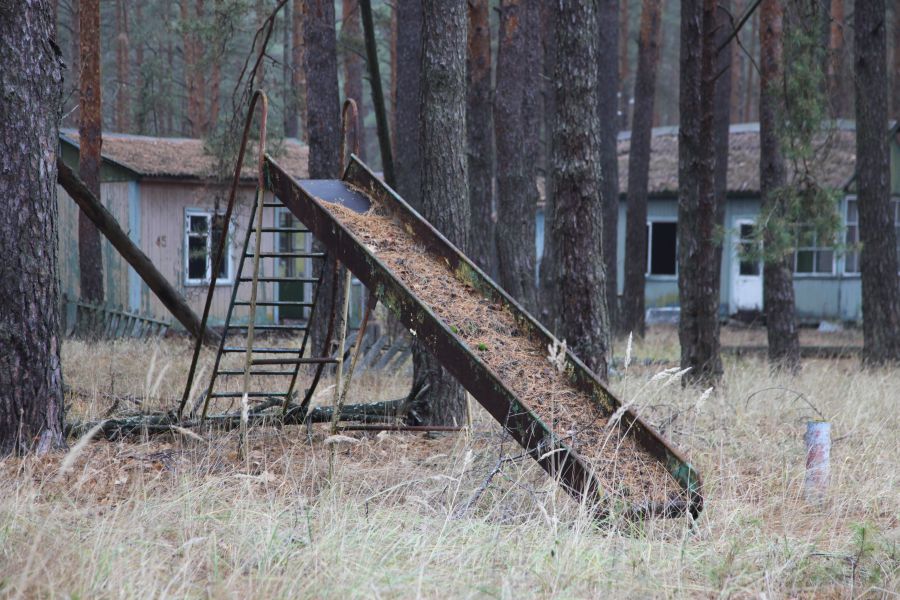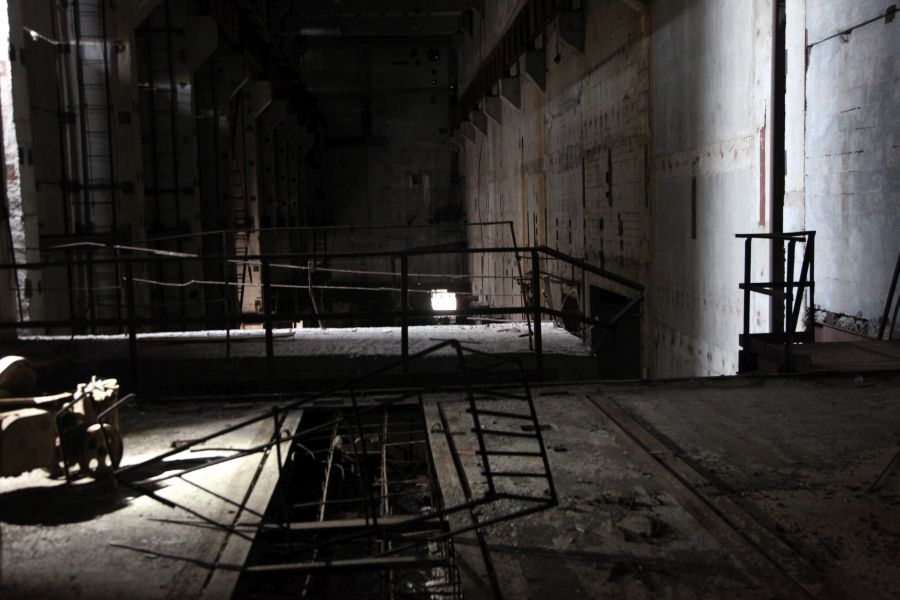The radiation from the “elephant’s foot” slag-flow under the reactor at Chernobyl would flat-out kill a human in about 5 minutes. Two minutes’ exposure would be a death sentence.

The children’s camp, near Pripyat (Chernobyl) – mjr, 2011
Apparently, that does not bother some life-forms. I was listening to TWIM (This Week in Microbiology) and they mentioned that a whole stack of archaea and some fungi are now successfully colonizing the room under the blown reactor. I’m sure researchers will have a great time trying to learn their tricks for reproducing and surviving that level of radiation.
Extensive fungal growth has been detected on the walls and other building constructions in the inner parts of the Shelter of the damaged fourth Unit of the Chernobyl Nuclear Power Plant in 1997-98. The mycobiota comprised 37 species of 19 genera. Zygomycetes and ascomycetes were represented by one species each: Mucor plumbeus and Chaetomium globosum, respectively. Two mitosporic fungi commonly found were Cladosporium sphaerospermum and Penicillium hirsutum. Alternaria alternata, Aureobasidium pullulans, Aspergillus versicolor, Acremonium strictum, and Cladosporium herbarum were also encountered. Penicillium ingelheimense, Phialophora melinii, Doratomyces stemonitis and Sydowia polyspora were isolated from the Shelter and are recorded from the Ukraine for the first time. Comparison of the species growing under both severe and relatively weak radioactive contamination revealed a dominance of melanin-containing species in heavily contaminated sites; biodiversity and prevalence coefficients supported this.
I suppose it’s to be expected, but for some reason I found this to be cheerful news. Evolution is such an amazing algorithm!

The fuel loading hall, reactor 6, Chernobyl. mjr, 2011

Evolution? Maybe it is the work of Da Lawd to develop a replacement species once we blow ourselves up during the first administration of Ivanka Trump in 2029!
…in 1986, apparently. It’s somewhat less now.
My naive guess is another 300 times less by now though as the underlying processes/composition change the rate may not be steady. There don’t appear to be any easy to find updates after 1996.
Wow. That is super cool. If I had another life to live I’d become a mycologist… fungi and just flat out amazing.
It has been shown before that fungi can absorb heavy metals and other toxic materials.
https://analyticalscience.wiley.com/do/10.1002/sepspec.168dc7ae17c/full/
https://www.ncbi.nlm.nih.gov/pmc/articles/PMC5981958/
I can’t find it, but I read a news item a few years ago about the proposed use of fungi in Brazil to clean up rivers and land poisoned by gold mining. If fungi could be used to control Chernobyl and Sendai’s nuclear messes, it would be a good thing.
Penicillium living in a high-radiation environment?
I’m developing a new antibiotic – nuclear penicillin! It is invincible!
xohjoh2n @ #2: the decay of one isotope is exactly exponential, so if it decreased to one tenth in ten years, it’ll decrease to a tenth of that in ten more years, and so on. But this is a mix of things that decay at various rates, so the overall decrease in radioactivity is not exponential. Assuming exponential decrease for a mixture will always underestimate the actual curve, possibly by a very large margin. It could very well have decayed to a tenth in ten years, then to half that in the next twenty-five. (To a much lesser extent, some isotopes in the mixture may absorb radiation and get transformed, too. With some types of neutron capture, it’s even possible to make a mix that becomes more radioactive as time passes, at least for a while. If you think about it, this is also true of nuclear reactors themselves. The “elephant’s foot” used to be slightly enriched uranium, which was barely radioactive — and now look at it. (Actually, don’t look at it — bad idea.))
@6 I figured, but I can’t find any better numbers. (Except to say that it is nowadays maintaining itself slightly above room temperature, so it must have gone down a fair bit.)
Without fungi the world would be very shitty.
@ Intransitive, #4: Gold mining cleanup? Oh, I know this one!
Well, I don’t know about Brazil specifically, but when it comes to gold mining, cyanide is often used – not so much in places where the ore is contained, but outside in the wider environment where it can spread everywhere.
Mines leave behind tailings – giant heaps of discarded earth out in the open.
They come along and essentially hose down the mine tailings with strong cyanide solutions, and then catch the flow that comes back out with the dissolved gold inside.
The first problem is that this leaves enormous amounts of cyanide contamination dispersed over a wide area. The second is that the cyanide solutions (made to dissolve gold) also dissolve other heavy metals and carry them out and into the wider environment. Cyanide AND heavy metals? Yum yum!
The second problem is that there is no profit to be made from the mine anymore, so the profiteers up and leave behind a giant mess for the locals to clean up, because fuck ’em.
Now is the part that’s pretty cool: In some places, cyanide-eating bacteria start to flourish. They can be fed/fertilized to help them work, but once they have a foothold they munch away pretty well.
That’s actually how I heard about this in the first place – gold miners in Australia were having trouble because in one place, the bacteria was expanding so ferociously it kept eating the cyanide before the miners could get to it to extract the gold.
In other words…. Cyanide AND heavy metals? Yum yum!
Jazzlet @ 8
True, but I wouldn’t want to live in a building infested by Aspergillus versicolor, it’s both carcinogenic and smelly, producing nasty mycotoxins. I grant you, in Chernobyl carcinogenic molds may not be your biggest problem.
In soil, the fungi are essential and some of them (like Penicillium expansum) produce much less toxins in soil than inside buildings according to a very experienced microbiologist here in Finland.
IIRC, this topic was covered in another post here recently, and I noted back then that it gives me flashbacks to the manga/anime film Nausicaa of the Valley of Wind by Hayao Miyazaki.
Perhaps we are all evolutionary narcissists who malignantly spend far too much time contemplating our self-assumed central role in the wider exosphere. As a moving body we have far more non-human microbia on and in us than human cells. We, might be more properly thought of as walking petri dishes programed to provide unique and interesting environments for the entertainment, progress and betterment of microbes generally. Think about the relatively small proportion of microbes allowed exposure to high radiation environments. Or the bags of waste left on the moon. Or the microbes left on the Voyager probes even after our attempts to sterilize it. Earth microbes are leaving our solar system. May be that is the plan and the main purpose of humanity : To disperse the wee critters that really run everything.
We flatter ourselves thinking we are in charge. But come 0700 I will be carrying a small plastic bag of dog poop around the neighborhood. Am I walking the dogs or are they walking me? Or am I walking the poop. Sometimes I’m not sure who, or what, is in charge. Until I get a cup of Joe I’m damn sure it isn’t me.
Nothing is in charge. That would be teleology, and teleology is bullshit (caffeine or no caffeine).
Also, this: https://www.theguardian.com/environment/2020/dec/15/scientists-find-two-new-species-of-fungi-that-turn-flies-into-zombies